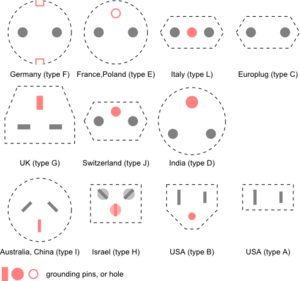Connecting homes to the electrical grid

Connecting homes to the electrical grid is the final stage of the electrical grid. After the distribution grid's substations have stepped-down the voltage to safe levels, this stage may be accomplished. Wires lead off from the neighbourhood's power lines and connect to individual buildings (homes, apartments, businesses, etc) by first going through the electric meter to measure how much electricity the home uses. The electricity then passes through a service panel, which houses the electrical safety devices (circuit breakers and fuses). This service panel has all of the wires that run to the different electrical appliances around the house.[2]
Every home is connected to the electrical grid through some sort of fuse box or circuit breaker as shown in figure 1.
Service drop
The overhead power connection from the utility lines to the service entrance is referred to as the service drop. It has three wires; 1 neutral line and 2 hot lines. The hot lines maintain a certain potential (like 120 V) compared to the neutral line. There are two types of overhead service drops: a mast service drop and a clevis service drop. An underground service connection is referred to as service lateral.[2]

Mast service drop
The mast is the combination of the conduit and weather-head that is on top of the roof (Figure 2). The service drop attaches to the mast at the mast knob. "Drip loops" serve to first provide slack that reduces any mechanical stress on the power lines and prevent any water from traveling along the lines into the service drop conduit.[2]
Clevis service drop
The Clevis refers to the connectors which fastens the conductors of the service drop to the side of the building. In this setup the conduit and weather-head are secured to the sides of the residence below the roof line.[2]

Service lateral
This is an underground service entrance, the primary power lines pass through the conduit to the pad transformer input and the secondary power lines join the transformer output to the electrical service meter.[2]

Main disconnect
The main disconnect is utilized during emergencies to stop electrical power flow.
- The main disconnect may be accomplished through a main disconnect switch. This is an externally operated (EXO) switch, that is positioned in between the service meter and electrical panel (Figure 1).
- The main disconnect may also be accomplished by one or more circuit breakers housed in the electrical panel, in order for this to work the circuit breakers must be in series with the two hot lines of the conductors because it must cut power to all circuits.[2]
Outlets
Electrical outlets provide a means of connecting various devices which require electricity. There are many different types of outlets around the world, with varying voltage and electric current properties.[6] Some are shown in Figure 4.
For Further Reading
For further information please see the related pages below:
- Electrical transmission
- Electrical grid
- Electrical outlet
- Distribution grid
- Or explore a random page!
References
- ↑ Wikimedia Commons [Online], Available: https://upload.wikimedia.org/wikipedia/commons/5/5d/US_wiring_basement-panel.jpg
- ↑ 2.0 2.1 2.2 2.3 2.4 2.5 R.T. Paynter, “Basic Electric Components and Meters,” in Introduction to Electricity, 1rst ed. NJ: Prentice-Hall, 2011, ch. 8, sec. 8.1, pp. 331-340.
- ↑ Wikimedia Commons [Online], Available: https://upload.wikimedia.org/wikipemmons/e/ea/Residence_service_drop.JPG
- ↑ sdpitbull via Flickr [Online], Available: https://www.flickr.com/photos/stevestr/4624935949
- ↑ (2014, Jul. 23). File:Plugs.png [Online]. Available: http://wikitravel.org/shared/File:Plugs.png
- ↑ R.T. Paynter, “Basic Electric Components and Meters,” in Introduction to Electricity, 1rst ed. NJ: Prentice-Hall, 2011, ch. 8, sec. 8.2, pp. 341-346.

